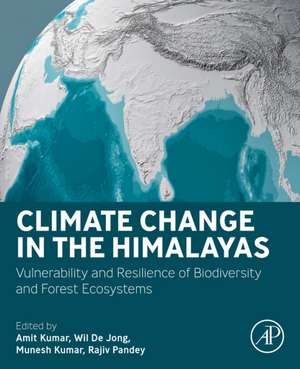Climate Change in the Himalayas: Vulnerability and Resilience of Biodiversity and Forest Ecosystems
Editat de Amit Kumar, Wil De Jong, Munesh Kumar, Rajiv Pandeyen Limba Engleză Paperback – 9 aug 2023
As many plant and animal species continue to be classified as extinct due to climate change, urbanization, and failing ecosystems, analyses and techniques in this book offer resolutions for sustaining current risks and curbing future risks. These can also be applied to other biodiverse, at-risk regions of the world.
- Offers nature-based solutions, along with policy and governance measures, such as the application of the UNFCCC Paris Agreement
- Provides mitigation and adaptation processes for current and future climate change impacts
- Includes a focus on soil sustainability
Preț: 899.31 lei
Preț vechi: 1179.45 lei
-24% Nou
Puncte Express: 1349
Preț estimativ în valută:
172.10€ • 186.88$ • 144.57£
172.10€ • 186.88$ • 144.57£
Carte tipărită la comandă
Livrare economică 15-29 aprilie
Preluare comenzi: 021 569.72.76
Specificații
ISBN-13: 9780443194153
ISBN-10: 0443194157
Pagini: 286
Dimensiuni: 191 x 235 mm
Editura: ELSEVIER SCIENCE
ISBN-10: 0443194157
Pagini: 286
Dimensiuni: 191 x 235 mm
Editura: ELSEVIER SCIENCE
Cuprins
1. An overview of Himalayan forests
2. Assessment and Management of Small Farmer’s Climate Risks in the Hills and Plains of Nepal
3. Categorization of farmer's response to climate change between coping and adaptation action
4. Forest Transition and Ecosystem Services in Himalaya
5. Viable land use options to achieve multiple ecosystem services in Eastern Himalayas of India
6. Carbon in Forest ecosystem in difficult terrains on Himalaya
7. Climate-resilient pathways and nature-based solutions to reduce vulnerabilities to Climate change in the Indian Eastern Himalayas
8. REDD+ and Its Implementation in Himalayan Region: Policy Issues
9. Modelling SOC in the Indian Himalayan region: implications for carbon management
10. Leveraging on technology-driven information systems for conservation through informed decisions in the Hindu Kush Himalayas
11. Ecosystem Services of Indian Himalayan Region in a Changing Environment: An overview
12. Raging forest fires in Hindukush Himalaya; socio-environmental dimensions and adaptation mechanisms
13. Carbon stock inventory and biomass production in different land use systems of North-Western Himalaya
14. Vulnerability assessment of forest ecosystems: climate change perspective
15. Synthesis and conclusions
2. Assessment and Management of Small Farmer’s Climate Risks in the Hills and Plains of Nepal
3. Categorization of farmer's response to climate change between coping and adaptation action
4. Forest Transition and Ecosystem Services in Himalaya
5. Viable land use options to achieve multiple ecosystem services in Eastern Himalayas of India
6. Carbon in Forest ecosystem in difficult terrains on Himalaya
7. Climate-resilient pathways and nature-based solutions to reduce vulnerabilities to Climate change in the Indian Eastern Himalayas
8. REDD+ and Its Implementation in Himalayan Region: Policy Issues
9. Modelling SOC in the Indian Himalayan region: implications for carbon management
10. Leveraging on technology-driven information systems for conservation through informed decisions in the Hindu Kush Himalayas
11. Ecosystem Services of Indian Himalayan Region in a Changing Environment: An overview
12. Raging forest fires in Hindukush Himalaya; socio-environmental dimensions and adaptation mechanisms
13. Carbon stock inventory and biomass production in different land use systems of North-Western Himalaya
14. Vulnerability assessment of forest ecosystems: climate change perspective
15. Synthesis and conclusions

















